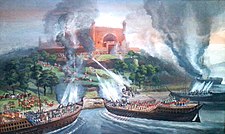Bengal came into the domain of Mughal Empire during the reign of Akbar after the Battle of Tukaroi which was fought in 1575 near the village of Tukaroi now in Balasore District, West Bengal between the Mughals and the Karrani Sultanate of Bengal and Bihar. At that time Dhaka became the capital of the Mughal province of Bengal. But due to its geographical remoteness it was a bit difficult to govern the region. Especially the section east of the Brahmaputra river remained outside the mainstream Mughal influence. The Bengali ethnic and linguistic identity further crystallized during this period, since the whole of Bengal was united under an able and long-lasting administration. Furthermore, its inhabitants were given sufficient autonomy to cultivate their own customs and literature.
Islam Khan
In 1612, during Emperor Jahangir's reign, the defeat of Sylhet completed the Mughal conquest of Bengal except for Chittagong. At this time Dhaka rose in prominence by becoming the provincial capital of Bengal. Chittagong was later annexed in order to stifle Arakanese raids from the east. A well-known Dhaka landmark, Lalbagh Fort, was built during Aurangzeb's sovereignty.
Islam Khan was appointed the Subahdar of Bengal in 1608 by Mughal emperorJahangir. He ruled Bengal from his capital Dhaka which he renamed as Jahangir Nagar. His major task was to subdue the rebellious Rajas, Bara-Bhuiyans, Zamindars and Afghan chiefs. He fought with Musa Khan, the leader of Bara-Bhuiyans and by the end of 1611 he was subdued. Islam Khan also defeated Pratapaditya of Jessore, Ram Chandra of Bakla and Ananta Manikya of Bhulua. Then he annexed the kingdoms of Koch Bihar, Koch Hajo and Kachhar thus taking total control over entire Bengal excepting Chittagong
Shaista Khan
Shaista Khan was appointed the Subahdar (Governor) of Bengal upon the death of Mir Jumla II in 1663. He was the longest-serving governor of Bengal as he ably ruled the province from his administrative headquarters in Dhaka for almost 24 years from 1664 to 1688 AD. As governor, he encouraged trade with Europe, Southeast Asia and other parts of India. He consolidated his power by signing trade agreements with European powers. Despite his powerful position he remained loyal to emperor Aurangzeb.
Shaista Khan's great fame in Bengal chiefly rests on his re-conquest of Chittagong. Though Chittagong came under the suzerainty of Bengal during SultanFakhruddin Mubarak Shah's reign in 1342 and the Bengal Sultanate until the 16th century, it subsequently went to the hands of Arakanese rulers in 1530. Considering the strategic importance of the Chittagong port, Shaista Khan gave the highest priority to recapture it and conquested Chittagong in January 1666 AD. The conquest brought a relief and peace much to the popular mass as pirates have caused a great distress to public life.
The Nawabs of Bengal
Murshid Quli Khan ended the nominal Mughal rule in 1717 when he declared Bengal's independence from the Mughal empire. He shifted the capital to Murshidabad ushering in a series of independent Bengal Nawabs.
The founder of the Nasiri, Murshid Quli Jafar Khan, was born a poor Deccani OriyaBrahmin before being sold into slavery and bought by one Haji Shafi Isfahani, a Persianmerchant from Isfahan who converted him to Islam. He entered the service of theEmperor Aurangzeb and rose through the ranks before becoming Nazim of Bengal in 1717, a post he held until his death in 1727. He in turn was succeeded by his grandson and son-in-law until his grandson was killed in battle and succeeded by Alivardi Khan of the Afshar Dynasty in 1740.
The Afshar, ruled from 1740 to 1757. They were succeeded by the third and final dynasty to rule Bengal, the Najafi, when Siraj Ud Daula, the last of the Afshar rulers was killed at the Battle of Plassey in 1757.
Nawab Alivardi Khan showed military skill during his wars with the Marathas when they first invaded Bengal. He repulsed the first Maratha invasion from Bengal. He crushed an uprising of the Afghans in Bihar and made the British pay 150,000 Tk for blocking Mughal and Armenian trade ships. But the Marathas of the Maratha Empire invaded Bengal again and during the fourth Maratha invasion the Nawab Alivardi Khan was defeated and compelled to come to terms with the Marathas of the Maratha Empire. He agreed to pay twelve lakhs of rupees annually as the chauth of Bengal, and ceded the province of Orissa to the Marathas.




No comments:
Post a Comment